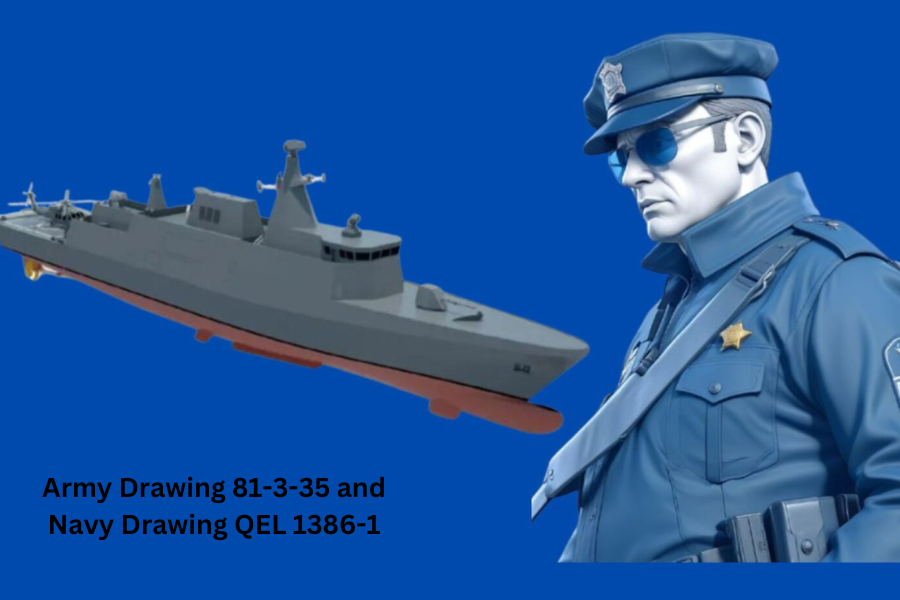Defining Army Drawing 81-3-35
Army Drawing 81-3-35 is a technical schematic that outlines the details of specific military equipment or systems. These drawings include precise measurements, materials, assembly instructions, and specifications required to manufacture or maintain military hardware. The scope can vary from vehicle components to specialized field equipment, but the common denominator is its focus on ensuring that the equipment meets the high standards set by military protocols.
In essence, this drawing serves as a blueprint, guaranteeing that every item is designed and produced to fulfill the rigorous demands of military operations. Its value lies in its accuracy—there’s no room for error when it comes to the functionality and safety of military assets, which is why technical drawings like Army Drawing 81-3-35 are essential.
Why Army Drawing 81-3-35 Is Crucial
Army Drawing 81-3-35 is pivotal for maintaining consistency across all manufactured equipment. This level of precision is vital when the equipment is deployed in high-risk environments such as combat zones. If there were discrepancies in production or maintenance, there could be catastrophic failures in the field, jeopardizing both the safety and success of the mission.
Defining Navy Drawing QEL 1386-1
Navy Drawing QEL 1386-1 is a similar technical document but specific to naval equipment. These drawings are primarily concerned with the electrical and electronic components that are integral to naval vessels, such as ships, submarines, and aircraft. The QEL drawings ensure that the electrical systems onboard these crafts are manufactured and maintained to a uniform standard, mitigating the risk of failure during critical operations.
Much like Army drawings, Navy drawings are indispensable in ensuring that equipment functions without failure, especially under extreme conditions where reliability is paramount.
Key Aspects of Navy Drawing QEL 1386-1
Typically, Navy drawings like QEL 1386-1 include the following:
- Electrical schematics: These diagrams illustrate how the various electronic components within a system are interconnected.
- Wiring guidelines: They provide detailed instructions to ensure the wiring setup is correct and prevents electrical issues.
- Component inventories: A complete list of the necessary components required for the system to operate.
- Material requirements: Specifications for materials, such as wires and circuit boards, which must meet military standards.
The Navy operates in challenging environments, dealing with high moisture levels, fluctuating temperatures, and constant movement. Therefore, the precision and dependability of these documents are crucial for maintaining operational readiness.
Why Navy Drawing QEL 1386-1 Is Important
Reliability is a cornerstone of Navy operations, as the functionality of a naval vessel’s electronic systems is directly tied to its success. A single malfunction could incapacitate an entire ship, leading to disastrous outcomes. Therefore, Navy Drawing QEL 1386-1 ensures that every component meets the stringent requirements necessary for safe and effective naval operations.
The Significance of Standardization in Military Drawings
The Role of Standardization in Military Equipment
Both Army Drawing 81-3-35 and Navy Drawing QEL 1386-1 underscore the importance of uniformity in military equipment. Regardless of whether the system is a vehicle in the Army or a piece of electrical equipment in the Navy, consistency is crucial to maintaining quality and operational safety.
Ensuring Consistency Across Equipment
Military technical drawings help ensure that each piece of equipment is manufactured to the same exacting standards, regardless of location or time of production. This consistency is vital for several reasons:
- Interchangeability: Parts manufactured in different locations or at different times must be compatible and replaceable without issues.
- Training: When equipment is standardized, it simplifies training for military personnel, as they don’t have to learn varying procedures for different versions of the same system.
- Safety: Uniform production methods mitigate the risks posed by inconsistencies in manufacturing, which could lead to malfunctions or safety hazards, especially in high-risk combat situations.
Cost-Effectiveness Through Standardization
Standardizing military drawings allows for significant cost savings. Rather than producing custom parts for every piece of equipment, manufacturers can produce standardized parts in bulk. This reduces production costs and simplifies repair and maintenance processes, as parts are readily available and interchangeable.
Army Drawing 81-3-35 vs. Navy Drawing QEL 1386-1: A Comparison
- Focus: Army Drawing 81-3-35 primarily concerns Army-specific equipment, including vehicles, weapon systems, and mechanical components. On the other hand, Navy Drawing QEL 1386-1 is tailored to electrical and electronic systems used in naval operations, such as those found on ships, submarines, or naval aircraft.
- Content: Army drawings often involve mechanical assembly instructions and physical component specifications. In contrast, Navy drawings tend to focus more on electrical schematics, wiring diagrams, and electronic component lists.
- Operational Environments: Army equipment is often deployed in diverse environments, including deserts, forests, and mountainous terrains, while naval equipment must endure the harsh conditions of the ocean, including saltwater, moisture, and constant movement.
Insights Beyond Conventional Understanding
The Evolution of Military Drawings
Both Army and Navy technical drawings are regularly updated to incorporate new technologies and improvements. Staying current with the latest version of these documents is essential for meeting modern military standards and ensuring that equipment remains operational and effective.
Collaborative Efforts Between Branches
Although these drawings are specific to the Army and Navy, there are often instances of collaboration between the two branches. Equipment used by the Army may need to be adapted for naval use, or vice versa. These drawings play a key role in ensuring that such modifications can be made without compromising functionality.
Environmental Adaptations
Army and Navy equipment face distinct environmental challenges. For instance, Army vehicles may endure extreme heat, dust, and rugged terrain, while Navy systems must withstand the corrosive effects of saltwater and the unpredictable nature of sea movements. Both sets of drawings account for these environmental factors to ensure reliability under any conditions.
Key Facts About Army Drawing 81-3-35 and Navy Drawing QEL 1386-1:
Purpose:
Both Army Drawing 81-3-35 and Navy Drawing QEL 1386-1 are technical documents designed to provide precise details for military equipment and systems. These drawings ensure that all components meet the military’s high standards of performance, safety, and reliability.
Army Drawing 81-3-35:
- Focuses on mechanical and structural components used in Army equipment, such as vehicles, weapons, and other military hardware.
- Includes specifications, measurements, materials, and assembly instructions.
- Ensures that all Army equipment is built with uniformity, ensuring both safety and functionality under harsh conditions.
Navy Drawing QEL 1386-1:
- Primarily pertains to electrical and electronic systems used on naval vessels like ships, submarines, and aircraft.
- Provides detailed electrical schematics, wiring instructions, component lists, and material specifications.
- Essential for ensuring that naval equipment remains operational in challenging marine environments, such as saltwater corrosion and extreme temperatures.
Standardization:
- Both Army Drawing 81-3-35 and Navy Drawing QEL 1386-1 emphasize standardization to ensure consistency across all equipment, no matter when or where it’s manufactured.
- Standardized components are crucial for easy interchangeability, cost savings, and maintaining operational readiness across different branches of the military.
Environmental Considerations:
- Army equipment often operates in extreme conditions like deserts, mountains, and forests, while naval systems are designed to withstand the corrosive effects of seawater and the constant motion of ships and submarines.
- Both drawings account for these unique environmental factors to ensure that the equipment can function reliably in their respective environments.
Continuous Updates:
- Both Army and Navy drawings are periodically updated to incorporate new technologies and improvements. This ensures that military equipment stays current with evolving standards and remains effective during missions
Conclusion
The precision and standardization embedded in Army Drawing 81-3-35 and Navy Drawing QEL 1386-1 play a fundamental role in ensuring that military equipment functions as intended in diverse and challenging environments. These technical documents guarantee that everything, from vehicles to naval systems, operates safely and reliably, which is critical for mission success. By promoting consistency, safety, and cost-efficiency, they remain indispensable tools in the Army and Navy’s operational readiness..
Frequently Asked Questions About Army Drawing 81-3-35 and Navy Drawing QEL 1386-1:
1. What is the primary purpose of Army Drawing 81-3-35?
Army Drawing 81-3-35 is a technical blueprint that provides detailed information about military equipment used by the Army, such as mechanical parts, vehicles, and weapons. It includes specifications, assembly instructions, and material requirements necessary for manufacturing and maintaining these components.
2. What is the focus of Navy Drawing QEL 1386-1?
Navy Drawing QEL 1386-1 focuses on electrical and electronic systems used in naval vessels, such as ships, submarines, and aircraft. It includes wiring diagrams, component specifications, and material requirements, ensuring the electronic systems function efficiently in demanding marine environments.
3. Why is standardization important in these military drawings?
Standardization ensures that all components, whether made in different locations or at different times, are interchangeable and meet the same quality standards. This reduces costs, ensures compatibility, simplifies training for military personnel, and increases safety.
4. How do Army and Navy drawings differ in terms of their content?
Army drawings, like 81-3-35, typically focus on mechanical and structural components, while Navy drawings like QEL 1386-1 are centered around electrical systems and electronic components. Army drawings detail the physical assembly, while Navy drawings focus on wiring, schematics, and electronic specifications.
5. How do environmental conditions impact the designs in these technical drawings?
Army equipment must be designed to perform under extreme conditions such as high heat, dust, and rugged terrain, while Navy systems must be built to withstand saltwater, humidity, and constant motion. Both sets of drawings incorporate these environmental factors to ensure the equipment’s reliability in diverse conditions.
6. Are Army Drawing 81-3-35 and Navy Drawing QEL 1386-1 subject to updates?
Yes, both Army and Navy drawings are living documents. They are regularly updated to incorporate advancements in technology, improvements in design, and to adapt to new military requirements. This ensures that equipment remains modern, effective, and ready for deployment.
7. How does cross-branch collaboration affect these technical drawings?
While specific to the Army and Navy, there are instances where equipment from one branch may be adapted for use by the other. Cross-branch collaboration ensures that these technical documents remain flexible and allow for modifications without compromising functionality.
8. What are the consequences of not adhering to these technical drawings?
Failure to adhere to the specifications in these drawings can lead to equipment malfunctions, safety hazards, or mission failures. Precision and reliability are critical in military operations, and deviations from the outlined standards can have serious consequences in both combat and non-combat situations.
9. Can Army Drawing 81-3-35 and Navy Drawing QEL 1386-1 be used by civilian manufacturers?
These technical drawings are primarily intended for military contractors and manufacturers involved in producing or maintaining military equipment. However, certain components and specifications may be used by civilian manufacturers with appropriate clearance or licensing, especially if the equipment has civilian applications.
10. How do these drawings contribute to military readiness?
By ensuring that every piece of equipment is made to the same precise standards, these drawings help maintain uniformity and operational readiness. This consistency reduces the risk of equipment failure, ensuring that military personnel can rely on their gear in high-stakes environments like combat or naval missions.
Stay in touch to get more news & updates on Get Break News











